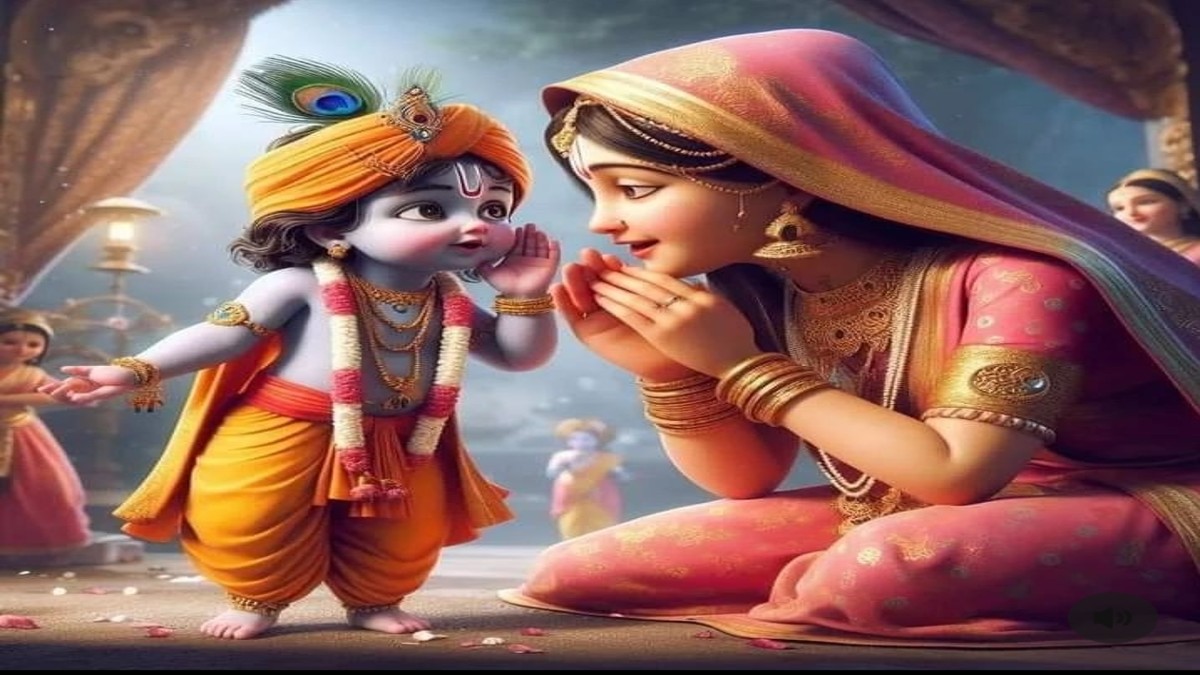
Krishna Janmashtami
Krishna Janmashtami, one of the most vibrant and widely celebrated festivals in Hinduism, commemorates the birth of Lord Krishna, the eighth incarnation of Lord Vishnu. Observed on the eighth day of the Krishna Paksha (dark fortnight) in the month of Bhadrapada (August-September), Janmashtami holds immense significance for millions of devotees across the world. In 2024, the festival falls on August 26th, a date marked with joy, devotion, and spiritual fervor.
The Significance of Krishna Janmashtami
Mythological Background
Lord Krishna is considered one of the most powerful and influential avatars of Lord Vishnu. His birth, as described in the Hindu epic Mahabharata, was to rid the world of tyranny and establish dharma (righteousness). Krishna was born in the Dwapara Yuga, a time when the earth was burdened by the atrocities of evil kings, particularly Kansa, the ruler of Mathura.
The story of Krishna’s birth is one of divine intervention. It is said that Kansa, a tyrant king, was foretold that his sister Devaki’s eighth son would be his destroyer. In his fear, Kansa imprisoned Devaki and her husband, Vasudeva, and killed their first seven children. However, the eighth child, Krishna, was miraculously saved. On the night of his birth, the prison guards fell asleep, the chains binding Vasudeva broke, and the doors of the prison opened on their own. Vasudeva carried the infant Krishna across the Yamuna River to Gokul, where he was raised by Nanda and Yashoda.
Krishna Janmashtami is celebrated to honor this divine birth and the subsequent acts of Krishna, which include the slaying of Kansa, the teachings of the Bhagavad Gita, and his playful and miraculous deeds as a child, youth, and adult.
Spiritual Significance
The festival is not just a commemoration of Krishna’s birth but also a time for devotees to reflect on the deeper meanings of his life and teachings. Krishna’s life exemplifies the triumph of good over evil, the importance of love and compassion, and the path of devotion (bhakti) as a means to attain spiritual enlightenment.
Krishna Janmashtami is an occasion for devotees to immerse themselves in the worship of Lord Krishna, seeking his blessings for peace, prosperity, and the strength to follow the path of righteousness.
Celebrations Across India
Krishna Janmashtami is celebrated with great enthusiasm and varied customs across different parts of India. Each region has its own unique traditions, reflecting the cultural diversity of the country.
Mathura and Vrindavan
Mathura, the birthplace of Lord Krishna, and Vrindavan, where he spent his childhood, are the epicenters of Janmashtami celebrations. The entire region comes alive with devotion, as thousands of pilgrims flock to the Krishna Janmabhoomi Temple in Mathura and the numerous temples in Vrindavan.
The celebrations in Mathura and Vrindavan include elaborate processions, temple rituals, and reenactments of scenes from Krishna’s life, known as Ras Lila. The temples are decorated with flowers, lights, and intricate rangolis. Devotees observe fasting, sing bhajans (devotional songs), and participate in midnight prayers, as it is believed that Krishna was born at the stroke of midnight.
Maharashtra: Dahi Handi
In Maharashtra, Janmashtami is synonymous with the Dahi Handi tradition, a reenactment of Krishna’s childhood sport of stealing butter. Dahi Handi involves the formation of human pyramids by groups called “Govindas,” who try to break a pot of curd (dahi) hung high above the ground. The event is both a religious ritual and a competitive sport, with participants competing for prizes.
Cities like Mumbai and Pune witness grand Dahi Handi events, with thousands of people gathering to watch the spectacle. The spirit of camaraderie, enthusiasm, and devotion that marks these events is a true reflection of Krishna’s playful and mischievous nature.
Gujarat: Makhan Chor
In Gujarat, Janmashtami is celebrated with a focus on Krishna as the “Makhan Chor” (butter thief). Devotees prepare offerings of butter, milk, and sweets, which are distributed among friends, family, and the poor. Temples are decorated with lights and flowers, and cultural programs, including Ras Garba (traditional dance), are organized to celebrate Krishna’s joyous and lively spirit.
Northern India: Fasting and Night Vigil
In North India, particularly in states like Uttar Pradesh, Bihar, and Rajasthan, Janmashtami is observed with strict fasting and night-long vigils. Devotees prepare special prasad (food offerings) and sing devotional songs throughout the night, awaiting the moment of Krishna’s birth. Temples and homes are beautifully decorated, and the air is filled with the sounds of conch shells and temple bells.
South India: Gokulashtami
In South India, the festival is known as Gokulashtami and is celebrated with equal fervor. In Tamil Nadu, devotees draw footprints of baby Krishna at the entrance of their homes, symbolizing his arrival. Special offerings of fruits, sweets, and savories are made, and homes are decorated with kolam (rangoli) patterns. The temples in Karnataka and Andhra Pradesh also see elaborate celebrations, with devotional music and dance performances.
West Bengal and Odisha: Nanda Utsav
In West Bengal and Odisha, the day following Janmashtami is celebrated as Nanda Utsav, marking the joyous occasion when Nanda and Yashoda celebrated the birth of Krishna in Gokul. Devotees offer sweets and fruits to the deity, and temples are filled with music and dance performances dedicated to Krishna.
Global Celebrations
Krishna Janmashtami is not limited to India; it is celebrated with equal devotion by the Indian diaspora across the world. Temples and cultural organizations in countries like the United States, United Kingdom, Canada, Australia, and the Caribbean organize grand events, bringing together communities to celebrate the festival.
ISKCON’s Global Presence
The International Society for Krishna Consciousness (ISKCON), also known as the Hare Krishna movement, plays a significant role in spreading the celebration of Janmashtami worldwide. ISKCON temples across the globe organize elaborate rituals, kirtans (devotional singing), and processions. The festivities often include dramatic reenactments of scenes from Krishna’s life, lectures on the Bhagavad Gita, and communal feasts.
ISKCON’s global reach has made Krishna Janmashtami a prominent event in many countries, attracting devotees and curious onlookers alike.
Celebrations in the United States
In the United States, Janmashtami is celebrated with great enthusiasm, particularly in cities with large Indian populations such as New York, Chicago, Los Angeles, and Houston. Temples like the Sri Sri Radha Krishna Temple in Utah and the Bhakti Center in New York City are known for their grand Janmashtami events, which include processions, cultural performances, and spiritual discourses.
The festival is also celebrated in homes, with families observing fasting, singing bhajans, and decorating their homes with images and idols of Krishna.
United Kingdom: Bhakti and Community Spirit
In the United Kingdom, the festival is celebrated in temples and community centers across cities like London, Leicester, and Birmingham. The Bhaktivedanta Manor, gifted by The Beatles’ George Harrison to ISKCON, is a focal point for Janmashtami celebrations in the UK. The manor hosts a two-day event that includes prayers, music, dance, and a dramatic presentation of Krishna’s life.
The celebrations attract thousands of devotees and visitors, highlighting the strong sense of community and devotion among the Indian diaspora in the UK.
Australia and Canada: A Growing Tradition
In Australia and Canada, Janmashtami celebrations have grown in prominence over the years. Cities like Sydney, Melbourne, Toronto, and Vancouver host vibrant events in temples and community centers, with devotees participating in kirtans, discourses, and feasts. The festival is also marked by cultural programs, where the younger generation learns about Krishna’s life and teachings through music, dance, and drama.
Rituals and Customs
Krishna Janmashtami is marked by a variety of rituals and customs, each reflecting the deep-rooted traditions and spiritual significance of the festival.
Fasting
Fasting is an integral part of Janmashtami. Many devotees observe a fast on this day, consuming only fruits and water, or a single meal of satvik (pure) food after midnight, when Krishna is believed to have been born. The fast is a symbol of devotion and self-discipline, allowing devotees to focus on their prayers and connection with the divine.
Midnight Celebrations
The highlight of Janmashtami is the midnight celebration, known as “Nandotsav.” It is believed that Krishna was born at midnight, and temples and homes across India resonate with the sound of devotional songs, chants, and prayers at this hour
Jhulan Yatra
Another important custom observed during Krishna Janmashtami is the “Jhulan Yatra,” where idols of Lord Krishna and his consort Radha are placed in an intricately adorned swing, known as a “jhula.” Devotees take turns swinging the idols while singing devotional songs and offering prayers. This ritual, celebrated with enthusiasm, particularly in Mathura, Vrindavan, and other regions, represents the playful and loving nature of Lord Krishna.
Rasa Lila and Krishna Leela
The enactment of Rasa Lila and Krishna Leela is a traditional performance that is deeply associated with Janmashtami. Rasa Lila refers to the divine dance that Krishna performed with the Gopis (milkmaids) of Vrindavan, symbolizing the eternal bond between the individual soul and the divine. Krishna Leela encompasses various episodes from Krishna’s life, including his childhood pranks, his encounters with demons, and his divine teachings.
These performances are an integral part of Janmashtami celebrations, especially in the Braj region (comprising Mathura, Vrindavan, and surrounding areas). Young boys and girls dress up as Krishna, Radha, and other characters from Krishna’s life and enact these stories, bringing to life the rich cultural heritage and religious fervor of the festival.
Dahi Handi Celebrations
As mentioned earlier, Dahi Handi is a key highlight of Janmashtami celebrations, particularly in Maharashtra. The ritual involves teams of young men forming human pyramids to reach and break a clay pot filled with curd, butter, and other goodies, hung at a significant height. The event is both a test of physical endurance and a demonstration of the participants’ devotion to Lord Krishna, who, as a child, was fond of stealing butter.
In recent years, Dahi Handi has evolved into a competitive sport, with teams, often sponsored by local businesses, competing for cash prizes and recognition. The event attracts large crowds, and the festive atmosphere is enhanced by music, dance, and loud cheers as the participants make their attempts.
Devotional Singing and Bhajans
Bhajans, or devotional songs, are an essential part of the Janmashtami celebrations. These songs, dedicated to Lord Krishna, are sung in temples, homes, and community gatherings. They range from traditional compositions to more contemporary renditions, reflecting the diverse musical traditions of India. The singing of bhajans, often accompanied by musical instruments like the harmonium, tabla, and dholak, creates an atmosphere of spiritual bliss and communal harmony.
In many regions, particularly in North India, “kirtans” (collective chanting of holy names) and “jagrans” (night-long devotional singing) are organized on the eve of Janmashtami. These gatherings bring together devotees who spend the night in prayer, song, and meditation, celebrating the birth of Lord Krishna.
Decorating Temples and Homes
The decoration of temples and homes is a vital aspect of Janmashtami celebrations. Temples are adorned with flowers, lights, and rangolis (intricate patterns made with colored powders). The sanctum sanctorum, where the idol of Krishna is placed, is often embellished with garlands of fresh flowers, silk fabrics, and ornaments, creating a divine and festive atmosphere.
In homes, devotees create small altars or “jhulans” (swings) for the idol of Bal Gopal. These are decorated with flowers, colorful fabrics, and lights. Special emphasis is placed on the cradle, which is often crafted with great care and attention to detail. Some families also prepare elaborate rangolis at the entrance of their homes, symbolizing the arrival of Lord Krishna.
Food Offerings and Prasad
Food offerings play a central role in Janmashtami celebrations. Devotees prepare a wide variety of dishes as “bhog” for Lord Krishna, which are later distributed as “prasad” among family, friends, and visitors. The offerings typically include sweets like “makhan mishri” (butter and sugar), “peda,” “ladoo,” and “kheer” (rice pudding), as well as savory items like “poha” (flattened rice) and fruits.
The preparation and offering of these delicacies are done with great devotion, as it is believed that Krishna, as a child, loved to eat butter and sweets. The distribution of prasad is a way of sharing the blessings of the deity with everyone, fostering a sense of community and togetherness.
Contemporary Relevance of Krishna Janmashtami
While Krishna Janmashtami is rooted in ancient traditions, its significance remains profound in the contemporary world. The teachings of Lord Krishna, particularly those found in the Bhagavad Gita, continue to inspire millions of people around the globe.
The Bhagavad Gita and Its Teachings
One of the most important contributions of Lord Krishna to humanity is the Bhagavad Gita, a 700-verse scripture that is part of the Mahabharata. The Gita is a dialogue between Krishna and the warrior prince Arjuna, where Krishna imparts spiritual wisdom and guidance on various aspects of life, including duty, righteousness, and the nature of the self.
The teachings of the Bhagavad Gita are timeless and universal, addressing the fundamental questions of human existence. They emphasize the importance of performing one’s duty with detachment, the concept of selfless service (karma yoga), and the path of devotion (bhakti yoga) as a means to attain liberation (moksha).
In the modern world, where individuals are often confronted with dilemmas and challenges, the Gita offers practical guidance on how to lead a balanced and purposeful life. It encourages individuals to rise above material desires, embrace their responsibilities, and develop a sense of inner peace and equanimity.
Krishna as a Role Model
Lord Krishna, with his multifaceted personality, serves as a role model for people from all walks of life. His life story, as narrated in the scriptures, portrays him as a statesman, a warrior, a friend, a lover, and a divine guide. His actions and teachings exemplify qualities such as courage, wisdom, compassion, and humility.
In contemporary times, Krishna’s life serves as an inspiration for those who seek to navigate the complexities of life with grace and wisdom. His teachings encourage individuals to cultivate inner strength, face challenges with resilience, and approach life with a sense of purpose and devotion.
Cultural and Social Impact
Krishna Janmashtami also plays a significant role in preserving and promoting the cultural heritage of India. The festival is an occasion for communities to come together, celebrate their shared traditions, and pass on cultural values to the younger generation. Through rituals, performances, and community gatherings, Janmashtami fosters a sense of identity and belonging among people, both in India and in the global diaspora.
Moreover, the festival has a social dimension, as it encourages acts of charity and compassion. Many devotees engage in philanthropic activities, such as distributing food to the needy, donating to charitable organizations, and participating in community service. These acts of kindness reflect the teachings of Krishna, who advocated for a life of service and compassion.
Challenges and Opportunities
As with many traditional festivals, Krishna Janmashtami faces certain challenges in the modern world. These include the commercialization of the festival, environmental concerns related to the use of non-biodegradable materials in decorations, and the safety risks associated with large gatherings, particularly during events like Dahi Handi.
However, these challenges also present opportunities for innovation and sustainability. For instance, many communities are now adopting eco-friendly practices in their celebrations, such as using natural materials for decorations and avoiding the use of plastic. Additionally, the advent of digital technology has enabled devotees to participate in virtual celebrations, making the festival more accessible to people across the globe.
The ongoing relevance of Krishna Janmashtami lies in its ability to adapt to changing times while preserving its core spiritual and cultural values. By embracing sustainability, inclusivity, and innovation, the festival can continue to inspire and unite people for generations to come.
Conclusion
Krishna Janmashtami is more than just a religious festival; it is a celebration of life, love, and devotion. It is a time when millions of people come together to honor the birth of Lord Krishna, reflect on his teachings, and seek his blessings. The festival, with its rich traditions and vibrant celebrations, serves as a reminder of the timeless values that Krishna embodied—values that continue to resonate in the hearts and minds of people across the world.
As we celebrate Krishna Janmashtami on August 26, 2024, let us embrace the spirit of devotion, compassion, and righteousness that Lord Krishna exemplified. Let us take this opportunity to reconnect with our spiritual roots, strengthen our bonds with our communities, and contribute to the well-being of society. In doing so, we honor the legacy of Lord Krishna and ensure that his teachings continue to illuminate our lives in the modern world.





